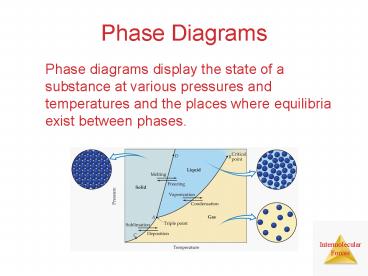Phase Diagrams PowerPoint PPT Presentation
Title: Phase Diagrams
1
Phase Diagrams
- Phase diagrams display the state of a substance
at various pressures and temperatures and the
places where equilibria exist between phases.
2
Phase Diagrams
- The AB line is the liquid-vapor interface.
- It starts at the triple point (A), the point at
which all three states are in equilibrium.
3
Phase Diagrams
- It ends at the critical point (B) above this
critical temperature and critical pressure the
liquid and vapor are indistinguishable from each
other.
4
Phase Diagrams
- Each point along this line is the boiling point
of the substance at that pressure.
5
Phase Diagrams
- The AD line is the interface between liquid and
solid. - The melting point at each pressure can be found
along this line.
6
Phase Diagrams
- Below A the substance cannot exist in the liquid
state. - Along the AC line the solid and gas phases are in
equilibrium the sublimation point at each
pressure is along this line.
7
Phase Diagram of Water
- Note the high critical temperature and critical
pressure - These are due to the strong van der Waals forces
between water molecules.
8
Phase Diagram of Water
- The slope of the solidliquid line is negative.
- This means that as the pressure is increased at a
temperature just below the melting point, water
goes from a solid to a liquid.
9
Phase Diagram of Carbon Dioxide
- Carbon dioxide cannot exist in the liquid state
at pressures below 5.11 atm CO2 sublimes at
normal pressures.
10
Phase Diagram of Carbon Dioxide
- The low critical temperature and critical
pressure for CO2 make supercritical CO2 a good
solvent for extracting nonpolar substances (such
as caffeine).
PowerShow.com is a leading presentation sharing website. It has millions of presentations already uploaded and available with 1,000s more being uploaded by its users every day. Whatever your area of interest, here you’ll be able to find and view presentations you’ll love and possibly download. And, best of all, it is completely free and easy to use.
You might even have a presentation you’d like to share with others. If so, just upload it to PowerShow.com. We’ll convert it to an HTML5 slideshow that includes all the media types you’ve already added: audio, video, music, pictures, animations and transition effects. Then you can share it with your target audience as well as PowerShow.com’s millions of monthly visitors. And, again, it’s all free.
About the Developers
PowerShow.com is brought to you by CrystalGraphics, the award-winning developer and market-leading publisher of rich-media enhancement products for presentations. Our product offerings include millions of PowerPoint templates, diagrams, animated 3D characters and more.

